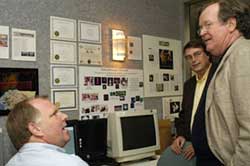UC Regent Peter Preuss Visits Calit2 Projects
|
12.10.02 -- A pioneer in the computer graphics software industry got a hands-on tour of two new visualization systems being deployed by researchers at UCSD affiliated with Calit². Preuss Foundation president and University of California Regent, Peter Preuss viewed the systems when he visited labs at the San Diego Supercomputer Center (SDSC) and the Scripps Institution of Oceanography (SIO). "We are looking for guidance from Peter, especially on the future use of visualization tools in the classroom," said Calit² director Larry Smarr, who accompanied Preuss on the tour. "We are already committed to a very substantial partnership with the Preuss School as part of the Calit²-led OptIPuter project."
The Preuss School is a charter school for grades 6-12 on the UCSD campus. It was chartered in 1998 as an intensive college preparatory program for low-income students under the San Diego Unified School District. It was named in recognition of a $5 million gift from Peter and Peggy Preuss, their son Peter, and the Preuss Family Foundation.
Peter Preuss, who arrived at UCSD in 1965 when the University had just 350 students, received his Master's degree in Mathematics in 1968, and in 1970 founded Integrated Software Systems Corp. (ISSCO), a San Diego-based software company specializing in computer graphics. ISSCO grew into one of the world's leading independent developers and suppliers of visual information systems software used to create high-quality graphics for business, government, scientific, engineering, and project management applications. Preuss sold the company in 1986 to Computer Associates. "It is stunning to see how far computer graphics have come since then," says Preuss. "I am especially excited that teachers and students at the Preuss School will be among the first users of these new visualization tools, and that they will play a role in helping Calit² and OptIPuter researchers develop the technology for improved education. What an opportunity for the students to become familiar and get hands-on experience not only with today's technology, but also with the technology of the future!"
At SDSC's Design Visualization Lab, Preuss got a sneak peek at an OptIPuter-funded visualization system that will be replicated within months at the Preuss School. When installed, it will feature a 7-foot diagonal screen, two projectors, and a very bright image (3,000 lumens). Inside the computer are two graphics cards, one that accelerate the display of lines and polygons, the other that accelerates the display of volumes.
|
"The latest technology even allows for 3D viewing, and each of the kids at the Preuss School using the facility will each have a pair of 3D glasses," said lab director Mike Bailey. "We are right now working with teachers at the School in order to create a curriculum based on the new system's capabilities."
Bailey demonstrated a toolkit produced by a company called GeoFusion that is being adapted for earth-science teachers at the Preuss School. "The teacher can say, 'Okay kids, today we are going to learn about the Himalayas,' and they zoom in, while the system flips through new textures and geometry," said Bailey. "For the Himalayas we can also exaggerate the height so that it stands out more clearly as you're zooming in from a planetary view. And doing this in 3D makes it a very compelling learning experience."
"This should be immediately useful in a geology curriculum," noted Preuss, scanning the screen through his 3D glasses.
Bailey is now working on a control interface "that is more intuitive for the students," he said. "Just imagine how much more time students will want to spend on this type of educational tool."
"If you use a game controller, kids have become familiar with them on Nintendo and other games," added Preuss. "So suddenly it is more of a game than a scientific device, and students will be more likely to learn."
Noted Smarr: "The goal is to make science interactive, and to make discovering science as easy as a videogame."
|
Smarr and Preuss also got a demo of wall-sized visualization tools at a Calit² facility at the Scripps Institution of Oceanography. Scripps Deputy Director John Orcutt and Scripps researchers Frank Vernon, Deborah Kilb, Graham Kent, and Dan Sandwell showcased the Visualization Center at Scripps and its wall-to-wall, high-resolution "immersive" screen and visualization system. Because of its size, the Center will make it possible for classes of up to 40 students to sit in front of the panoramic screen at the same time-and even communicate "live" with students or experts sitting in a similar viz center at San Diego State University some 15 miles away (while simultaneously viewing broadband computer images transmitted between the two sites over an optical fiber network).
Observed Preuss: "This is a wonderful example about the creative energy the new Calit² brings to San Diego to the benefit of the whole City."
|
Related Links
OptIPuter News Release
Preuss School
Preuss Foundation
SDSC
SIO





